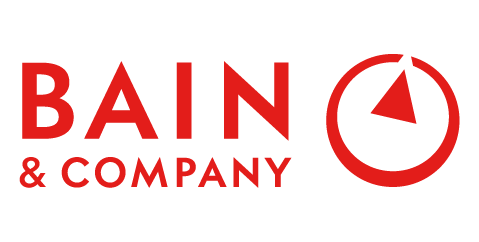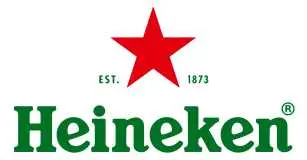
Aircraft Micro Turbine Engines Market Growth, Size, Trends, Revenue, Scope and Future Outlook
Aircraft Micro Turbine Engines Market Size- By Engine Type, By Platform, By Fuel Type, By Horsepower, By End User- Regional Outlook, Competitive Strategies and Segment Forecast to 2033
| Published: Jul-2023 | Report ID: AERO2321 | Pages: 1 - 235 | Formats*: |
| Category : Aerospace and Defence | |||
- June 2021: The Kratos Turbine Technologies (KTT) Division has just received a $8.6 million task order under the Advanced Turbine Technologies for Affordable Mission (ATTAM) ID/IQ contract, according to a recent announcement from Kratos Defence & Security Solutions, Inc. The contract entails the design, development, assembly, and testing of an affordable turbo shaft engine for Group 3 unmanned aerial vehicles (UAVs).
- February 2021: Prvni brnenska strojirna Velka Bites (PBS), a Czech Republic-based aerospace manufacturer with EASA certification, has revealed plans to introduce advanced high-performance jet engines. After successfully delivering their 1,000th PBS TJ100 turbojet engine in 2020, PBS is now responding to market demands by adapting their offerings to cater to disposable applications.
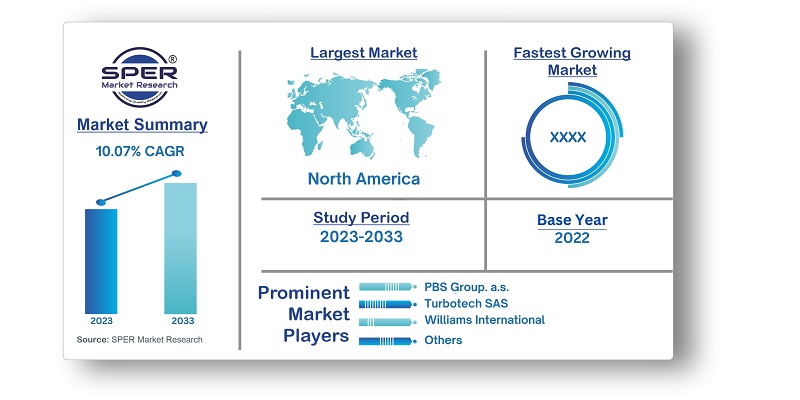
- Opportunities:
- Growing Demand for Unmanned Aerial Vehicles (UAVs): As UAVs are used more often in a variety of fields, including the military, surveillance, and commercial applications, there is a significant market for small, lightweight micro turbine engines that can power these unmanned aircraft.
- Fuel Efficiency and Emission Reduction: Aircraft micro turbine engines, in comparison to conventional reciprocating engines, offer improved fuel efficiency and reduced pollutants. Micro turbine engines, which can aid in lowering fuel consumption and carbon footprint, are becoming more and more popular as a result of the growing emphasis on environmental sustainability and strict emission standards.
- Challenges:
- Cost and Affordability: Compared to typical engines, micro turbine engines may have greater initial acquisition costs and ongoing operating costs. Wider market adoption is made more difficult by this, particularly for budget-constrained UAV producers or smaller aircraft operators.
- Certification and Regulatory Compliance: To achieve compliance with safety and regulatory standards, aircraft engines, especially micro turbine engines, must go through stringent certification processes. Engine manufacturers face a problem because certification can be time-consuming and expensive to obtain.

| Report Metric | Details |
| Market size available for years | 2019-2033 |
| Base year considered | 2022 |
| Forecast period | 2023-2033 |
| Segments covered | By Engine Type, By Platform, By Fuel Type, By Horsepower, By End User |
| Regions covered | Asia Pacific, Europe, Middle East and Africa, North America, Latin America |
| Companies Covered | AeroDesignWorks GmbH, Elliott Company, General Electric Company, Honeywell International Inc., Kratos Defense & Security Solutions, Inc., Micro Turbine Technology B.V., PBS Group. a.s., Sentient Blue Technologies, Turbotech SAS, Williams International, Others |
- Aircraft Maintenance, Repair, and Overhaul (MRO) Providers
- Aircraft Manufacturers
- Aviation Industry Suppliers
- Aviation Operators
- Aviation Regulatory Agencies
- Defense and Military Organizations
- Others
| By Engine Type: |
|
| By Platform: |
|
| By Fuel Type: |
|
| By Horsepower: |
|
| By End User: |
|
- Global Aircraft Micro Turbine Engines Market Size (FY’2023-FY’2033)
- Overview of Global Aircraft Micro Turbine Engines Market
- Segmentation of Global Aircraft Micro Turbine Engines Market By Engine Type (Turbojet, Turboshaft)
- Segmentation of Global Aircraft Micro Turbine Engines Market By Platform (Advanced Air Mobility, Commercial Aviation, General Aviation, Military Aviation)
- Segmentation of Global Aircraft Micro Turbine Engines Market By Fuel Type (Biofuel, Diesel, Jet A, Kerosene)
- Segmentation of Global Aircraft Micro Turbine Engines Market By Horsepower (5-50 HP, 50-100 HP, 100-200 HP)
- Segmentation of Global Aircraft Micro Turbine Engines Market By End User (Auxiliary Power, Propulsion)
- Statistical Snap of Global Aircraft Micro Turbine Engines Market
- Expansion Analysis of Global Aircraft Micro Turbine Engines Market
- Problems and Obstacles in Global Aircraft Micro Turbine Engines Market
- Competitive Landscape in the Global Aircraft Micro Turbine Engines Market
- Impact of COVID-19 and Demonetization on Global Aircraft Micro Turbine Engines Market
- Details on Current Investment in Global Aircraft Micro Turbine Engines Market
- Competitive Analysis of Global Aircraft Micro Turbine Engines Market
- Prominent Players in the Global Aircraft Micro Turbine Engines Market
- SWOT Analysis of Global Aircraft Micro Turbine Engines Market
- Global Aircraft Micro Turbine Engines Market Future Outlook and Projections (FY’2023-FY’2033)
- Recommendations from Analyst
1.1. Scope of the report1.2. Market segment analysis
2.1. Research data source
2.1.1. Secondary Data2.1.2. Primary Data2.1.3. SPER’s internal database2.1.4. Premium insight from KOL’s
2.2. Market size estimation
2.2.1. Top-down and Bottom-up approach
2.3. Data triangulation
4.1. Driver, Restraint, Opportunity and Challenges analysis
4.1.1. Drivers4.1.2. Restraints4.1.3. Opportunities4.1.4. Challenges
4.2. COVID-19 Impacts of the Global Aircraft Micro Turbine Engines Market
5.1. SWOT Analysis
5.1.1. Strengths5.1.2. Weaknesses5.1.3. Opportunities5.1.4. Threats
5.2. PESTEL Analysis
5.2.1. Political Landscape5.2.2. Economic Landscape5.2.3. Social Landscape5.2.4. Technological Landscape5.2.5. Environmental Landscape5.2.6. Legal Landscape
5.3. PORTER’s Five Forces
5.3.1. Bargaining power of suppliers5.3.2. Bargaining power of buyers5.3.3. Threat of Substitute5.3.4. Threat of new entrant5.3.5. Competitive rivalry
5.4. Heat Map Analysis
6.1. Global Aircraft Micro Turbine Engines Market Manufacturing Base Distribution, Sales Area, Product Type6.2. Mergers & Acquisitions, Partnerships, Product Launch, and Collaboration in Global Aircraft Micro Turbine Engines Market
7.1. Global Aircraft Micro Turbine Engines Market Value Share and Forecast, By Engine Type, 2023-20337.2. Turbojet7.3. Turboshaft
8.1. Global Aircraft Micro Turbine Engines Market Value Share and Forecast, By Platform, 2023-20338.2. Advanced Air Mobility8.3. Commercial Aviation8.4. General Aviation8.5. Military Aviation
9.1. Global Aircraft Micro Turbine Engines Market Value Share and Forecast, By Fuel Type, 2023-20339.2. Biofuel9.3. Diesel9.4. Jet A9.5. Kerosene
10.1. Global Aircraft Micro Turbine Engines Market Value Share and Forecast, By Horsepower, 2023-203310.2. 5-50 HP10.3. 50-100 HP10.4. 100-200 HP
11.1. Global Aircraft Micro Turbine Engines Market Value Share and Forecast, By End User, 2023-203311.2. Auxiliary Power11.3. Propulsion
12.1. Global Aircraft Micro Turbine Engines Market Size and Market Share
13.1. Global Aircraft Micro Turbine Engines Market Size and Market Share By Engine Type (2019-2026)13.2. Global Aircraft Micro Turbine Engines Market Size and Market Share By Engine Type (2027-2033)
14.1. Global Aircraft Micro Turbine Engines Market Size and Market Share By Platform (2019-2026)14.2. Global Aircraft Micro Turbine Engines Market Size and Market Share By Platform (2027-2033)
15.1. Global Aircraft Micro Turbine Engines Market Size and Market Share By Fuel Type (2019-2026)15.2. Global Aircraft Micro Turbine Engines Market Size and Market Share By Fuel Type (2027-2033)
16.1. Global Aircraft Micro Turbine Engines Market Size and Market Share By Horsepower (2019-2026)16.2. Global Aircraft Micro Turbine Engines Market Size and Market Share By Horsepower (2027-2033)
17.1. Global Aircraft Micro Turbine Engines Market Size and Market Share By End User (2019-2026)17.2. Global Aircraft Micro Turbine Engines Market Size and Market Share By End User (2027-2033)
18.1. Global Aircraft Micro Turbine Engines Market Size and Market Share By Region (2019-2026)18.2. Global Aircraft Micro Turbine Engines Market Size and Market Share By Region (2027-2033)18.3. Asia-Pacific
18.3.1. Australia18.3.2. China18.3.3. India18.3.4. Japan18.3.5. South Korea
18.3.6. Rest of Asia-Pacific
18.4. Europe
18.4.1. France18.4.2. Germany18.4.3. Italy18.4.4. Spain18.4.5. United Kingdom18.4.6. Rest of Europe
18.5. Middle East and Africa
18.5.1. Kingdom of Saudi Arabia18.5.2. United Arab Emirates18.5.3. Rest of Middle East & Africa
18.6. North America
18.6.1. Canada18.6.2. Mexico18.6.3. United States
18.7. Latin America
18.7.1. Argentina18.7.2. Brazil18.7.3. Rest of Latin America
19.1. AeroDesignWorks GmbH
19.1.1. Company details19.1.2. Financial outlook19.1.3. Product summary19.1.4. Recent developments
19.2. Elliott Company
19.2.1. Company details19.2.2. Financial outlook19.2.3. Product summary19.2.4. Recent developments
19.3. General Electric Company
19.3.1. Company details19.3.2. Financial outlook19.3.3. Product summary19.3.4. Recent developments
19.4. Honeywell International Inc.
19.4.1. Company details19.4.2. Financial outlook19.4.3. Product summary19.4.4. Recent developments
19.5. Kratos Defense & Security Solutions, Inc.
19.5.1. Company details19.5.2. Financial outlook19.5.3. Product summary19.5.4. Recent developments
19.6. Micro Turbine Technology B.V.
19.6.1. Company details19.6.2. Financial outlook19.6.3. Product summary19.6.4. Recent developments
19.7. PBS Group. a.s.
19.7.1. Company details19.7.2. Financial outlook19.7.3. Product summary19.7.4. Recent developments
19.8. Sentient Blue Technologies
19.8.1. Company details19.8.2. Financial outlook19.8.3. Product summary19.8.4. Recent developments
19.9. Turbotech SAS
19.9.1. Company details19.9.2. Financial outlook19.9.3. Product summary19.9.4. Recent developments
19.10. Williams International
19.10.1. Company details19.10.2. Financial outlook19.10.3. Product summary19.10.4. Recent developments
19.11. Others
SPER Market Research’s methodology uses great emphasis on primary research to ensure that the market intelligence insights are up to date, reliable and accurate. Primary interviews are done with players involved in each phase of a supply chain to analyze the market forecasting. The secondary research method is used to help you fully understand how the future markets and the spending patterns look likes.
The report is based on in-depth qualitative and quantitative analysis of the Product Market. The quantitative analysis involves the application of various projection and sampling techniques. The qualitative analysis involves primary interviews, surveys, and vendor briefings. The data gathered as a result of these processes are validated through experts opinion. Our research methodology entails an ideal mixture of primary and secondary initiatives.
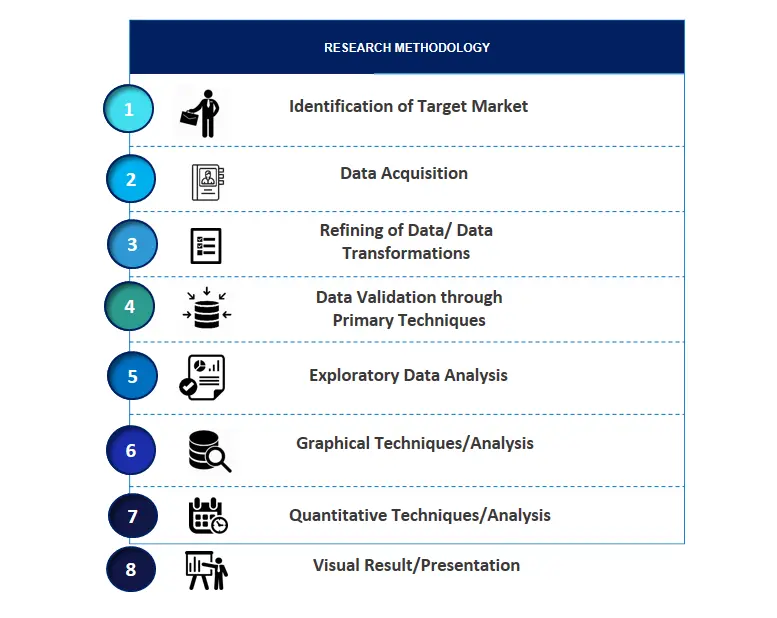
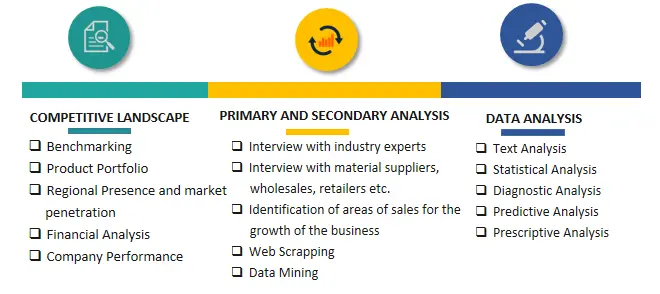

Frequently Asked Questions About This Report
PLACE AN ORDER
Year End Discount
Sample Report
Pre-Purchase Inquiry
NEED CUSTOMIZATION?
Request CustomizationCALL OR EMAIL US
100% Secure Payment






Related Reports
Our Global Clients
Our data-driven insights have influenced the strategy of 200+ reputed companies across the globe.







